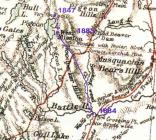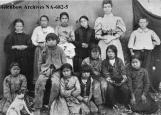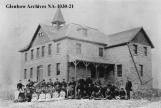2
In 1870, Treaty 6 was signed between the Government of Canada and the First Nations peoples of the region. After this time, the Samson, Ermineskin and Muddy Bull bands were assigned reserves in the Bear Hills along the Battle River, near present-day Hobbema. The Stoney people were relocated near Wolf Creek.In 1882, John Nelson came to the now abandoned mission, renamed Woodville in honour of former mission superintendent Josiah Wood. Nelson nevertheless reported that "public service, class meetings, and Sabbath school have been regularly sustained and well attended whenever the people were in."
4
Gerald Hutchinson:… John Nelson was appointed and he stayed up here for sometime. But by now the Indian agencies were operating and they said the hope for Aboriginal survival was assimilation and becoming farmers. Their judgment was that Pigeon Lake was not a good farming location and that the fishery in the lake had declined, so they best move this mission and community closer to this black soil…to move them into the Bear Hills, just west of Westaskiwin.
Those living at the lake were known as the Sharphead Stoneys; sort of an extended family group. And so they decided they'd move the whole group, plus the mission and the missionary, to Bear Hills. The idea was that they would have Cree on one side and Stoneys on the other, at the same mission. That didn't work at all. After a year there was just too much tension, so divided and moved the Stoney Mission to Wolf Creek. Do you know where Wolf Creek Golf course is now? Right where Wolf Creek joins the Battle River, south of Ponoka. So they moved the whole mission over there.
6
On the recommendation of government agents, a new mission was started at the Bear Hills and the Woodville Mission to the Stoney people was relocated to the east side of Pigeon Lake, on more fertile soil. The new reserve and mission arrangements created tensions between Cree and Stoney peoples, as well as between missionary and government agent.8
Gerald Hutchinson:… But now you had an Aboriginal reserve with two white authorities. You had the Indian agent with his authority and responsibility and you had two Methodist Ministers who were used to having quite a prominent place in the well being of that community. And the Methodists began to complain to the Indian agency in Ottawa that the Indian agent, Sam Lucas at Westaskwin, was bringing liquor onto the reserve and doing all kinds of bad things. They began to put the heat on Lucas and there was quite a stir in the early 1870s. Well, they got that one settled and two years later it broke out again. And they referred the issue back to Ottawa, who asked Sam Lucas to respond to this. I've got his correspondence in which he says "the Methodists are persecuting me" and that he had some liquor for his own purposes, that he didn't have parties on the reserve. But not only that. Lucas wrote "while they are criticizing me they're doing criminal acts themselves, chasing girls all the time and Muddy Bull's daughter had to jump off the wagon to get away from Brother Nelson. So that turned the heat on the Methodist missions in a hurry.
10
Although the allegations appeared unfounded, missions superintendent John McDougall sent John Nelson to another reserve and was later appointed principal of the Red Deer Indian Industrial School.Gerald Hutchinson:
... Nelson stayed there about two years. He had a rather tumultuous time at the industrial school and then went back to Norway House. It meant that the Pigeon Lake site was abandoned by 1883 and never again functioned as a mission. But they carried the name "Woodville" to three missions in other locations. That's why it stayed on the records until 1906. But in three different locations-that had us confused for a long time.
[note: Nelson was at RDIIS for nearly 2 years, contrary to Gerald's comment]
11
Excerpt of a letter by John Nelson, Methodist missionary at the Woodville Mission4 March 1886
Pigeon Lake, Alberta

12
John Nelson's 11 years in the region occured in a time of difficulty and relocation for Aboriginal peoples. Although isolated and remote, even the Riel Resistance did not entirely bypass the Woodville Missions. John Nelson advised the members of the community to not get involved in the struggle. Nelson later wrote:I advised them to pitch off on a hunt for a short time . . . While the tents were being pulled down and the horses packed, the head men met at the mission house, unsolicited, and asked me to write a letter to Gov. Dewdney, assuring him of their loyalty to the Government. Some of them expressed deep regret at leaving. One man said, 'My heart is sore leaving our church and school. I tell you this from my heart not with my lips only.' In times like the present, we feel the safest places are with those with whom we have been labouring.
John Nelson died in Woodbridge, Ontario in 1927, aged 78 years.




